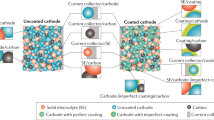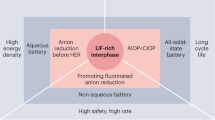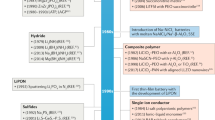Abstract
The discharging and charging of batteries require ion transfer across phase boundaries. In conventional lithium-ion batteries, Li+ ions have to cross the liquid electrolyte and only need to pass the electrode interfaces. Future high-energy batteries may need to work as hybrids, and so serially combine a liquid electrolyte and a solid electrolyte to suppress unwanted redox shuttles. This adds new interfaces that might significantly decrease the cycling-rate capability. Here we show that the interface between a typical fast-ion-conducting solid electrolyte and a conventional liquid electrolyte is chemically unstable and forms a resistive solid-liquid electrolyte interphase (SLEI). Insights into the kinetics of this new type of interphase are obtained by impedance studies of a two-chamber cell. The chemistry of the SLEI, its growth with time and the influence of water impurities are examined by state-of-the-art surface analysis and depth profiling.
This is a preview of subscription content, access via your institution
Access options
Subscribe to this journal
Receive 12 print issues and online access
$259.00 per year
only $21.58 per issue
Buy this article
- Purchase on Springer Link
- Instant access to full article PDF
Prices may be subject to local taxes which are calculated during checkout





Similar content being viewed by others
References
Liu, Z., Fu, W. & Liang, C. in Handbook of Battery Materials (eds Daniel, C. & Besenhard, J. O.) 811–836 (Wiley-VCH, 2012).
Ji, X. & Nazar, L. F. Advances in Li–S batteries. J. Mater. Chem. 20, 9821–9826 (2010).
Mikhaylik, Y. V. & Akridge, J. R. Polysulfide shuttle study in the Li/S battery system. J. Electrochem. Soc. 151, A1969–A1976 (2004).
Ellis, B. L., Lee, K. T. & Nazar, L. F. Positive electrode materials for Li-ion and Li-batteries. Chem. Mater. 22, 691–714 (2010).
Busche, M. R. et al. Systematical electrochemical study on the parasitic shuttle-effect in lithium–sulfur-cells at different temperatures and different rates. J. Power Sources 259, 289–299 (2014).
Rauh, R. D., Abraham, K. M., Pearson, G. F., Surprenant, J. K. & Brummer, S. B. A lithium/dissolved sulfur battery with an organic electrolyte. J. Electrochem. Soc. 126, 523–527 (1979).
Leitner, K. W., Wolf, H., Garsuch, A., Chesneau, F. & Schulz-Dobrick, M. Electroactive separator for high voltage graphite/LiNi0.5Mn1.5O4 lithium ion batteries. J. Power Sources 244, 548–551 (2013).
Bergner, B. J., Schürmann, A., Peppler, K. & Janek, J. TEMPO: a mobile catalyst for rechargeable Li–O2 batteries. J. Am. Chem. Soc. 136, 15054–15064 (2014).
Xiong, S., Xie, K., Diao, Y. & Hong, X. Characterization of the solid electrolyte interphase on lithium anode for preventing the shuttle mechanism in lithium–sulfur batteries. J. Power Sources 246, 840–845 (2014).
Lee, Y. M., Choi, N.-S., Park, J. H. & Park, J.-K. Electrochemical performance of lithium/sulfur batteries with protected Li anodes. J. Power Sources 119–121, 964–972 (2003).
Manthiram, A., Fu, Y., Chung, S.-H., Zu, C. & Su, Y.-S. Rechargeable lithium–sulfur batteries. Chem. Rev. 114, 11751–11787 (2014).
Chen, L. & Shaw, L. L. Recent advances in lithium–sulfur batteries. J. Power Sources 267, 770–783 (2014).
Zhang, S. S. Liquid electrolyte lithium/sulfur battery: fundamental chemistry, problems, and solutions. J. Power Sources 231, 153–162 (2013).
Adelhelm, P. et al. From lithium to sodium: cell chemistry of room temperature sodium–air and sodium–sulfur batteries. Beilstein J. Nanotechnol. 6, 1016–1055 (2015).
Hassoun, J. & Scrosati, B. A high-performance polymer tin sulfur lithium ion battery. Angew. Chem. Int. Ed. 49, 2371–2374 (2010).
Liang, X. et al. Highly dispersed sulfur in ordered mesoporous carbon sphere as a composite cathode for rechargeable polymer Li/S battery. J. Power Sources 196, 3655–3658 (2011).
Marmorstein, D. et al. Electrochemical performance of lithium/sulfur cells with three different polymer electrolytes. J. Power Sources 89, 219–226 (2000).
Hassoun, J. & Scrosati, B. Moving to a solid-state configuration: a valid approach to making lithium-sulfur batteries viable for practical applications. Adv. Mater. 22, 5198–5201 (2010).
Hayashi, A., Ohtomo, T., Mizuno, F., Tadanaga, K. & Tatsumisago, M. All-solid-state Li/S batteries with highly conductive glass–ceramic electrolytes. Electrochem. Commun. 5, 701–705 (2003).
Jin, Z., Xie, K., Hong, X., Hu, Z. & Liu, X. Application of lithiated Nafion ionomer film as functional separator for lithium sulfur cells. J. Power Sources 218, 163–167 (2012).
Huang, J.-Q. et al. Ionic shield for polysulfides towards highly-stable lithium–sulfur batteries. Energy Environ. Sci. 7, 347–353 (2014).
Bauer, I., Thieme, S., Brückner, J., Althues, H. & Kaskel, S. Reduced polysulfide shuttle in lithium–sulfur batteries using Nafion-based separators. J. Power Sources 251, 417–422 (2014).
Zhang, Z., Lai, Y., Zhang, Z., Zhang, K. & Li, J. Al2O3-coated porous separator for enhanced electrochemical performance of lithium sulfur batteries. Electrochim. Acta 129, 55–61 (2014).
Li, W. et al. A V2O5 polysulfide anion barrier for long-lived Li–S batteries. Chem. Mater. 26, 3403–3410 (2014).
Wang, Q. et al. A shuttle effect free lithium sulfur battery based on a hybrid electrolyte. Phys. Chem. Chem. Phys. 16, 21225–21229 (2014).
Vizintin, A., Patel, M. U. M., Genorio, B. & Dominko, R. Effective separation of lithium anode and sulfur cathode in lithium-sulfur batteries. ChemElectroChem 1, 1040–1045 (2014).
Wenzel, S. et al. Thermodynamics and cell chemistry of room temperature sodium/sulfur cells with liquid and liquid/solid electrolyte. J. Power Sources 243, 758–765 (2013).
Peng, Z., Freunberger, S. A., Chen, Y. & Bruce, P. G. A reversible and higher-rate Li–O2 battery. Science 337, 563–566 (2012).
Imanishi, N. et al. Lithium anode for lithium–air secondary batteries. J. Power Sources 185, 1392–1397 (2008).
Zhang, T. et al. Water-stable lithium anode with the three-layer construction for aqueous lithium–air secondary batteries. Electrochem. Solid State Lett. 12, A132–A135 (2009).
Sagane, F., Abe, T., Iriyama, Y. & Ogumi, Z. Li+ and Na+ transfer through interfaces between inorganic solid electrolytes and polymer or liquid electrolytes. J. Power Sources 146, 749–752 (2005).
Abe, T., Sagane, F., Ohtsuka, M., Iriyama, Y. & Ogumi, Z. Lithium-ion transfer at the interface between lithium-ion conductive ceramic electrolyte and liquid electrolyte—a key to enhancing the rate capability of lithium-ion batteries. J. Electrochem. Soc. 152, A2151–A2154 (2005).
Sagane, F., Abe, T. & Ogumi, Z. Li+-ion transfer through the interface between Li+-ion conductive ceramic electrolyte and Li+-ion-concentrated propylene carbonate solution. J. Phys. Chem. C 113, 20135–20138 (2009).
Yamada, I., Abe, T., Iriyama, Y. & Ogumi, Z. Lithium-ion transfer at LiMn2O4 thin film electrode prepared by pulsed laser deposition. Electrochem. Commun. 5, 502–505 (2003).
Abe, T., Fukuda, H., Iriyama, Y. & Ogumi, Z. Solvated Li-ion transfer at interface between graphite and electrolyte. J. Electrochem. Soc. 151, A1120–A1123 (2004).
Yamada, Y., Sagane, F., Iriyama, Y., Abe, T. & Ogumi, Z. Kinetics of lithium-ion transfer at the interface between Li0.35La0.55TiO3 and binary electrolytes. J. Phys. Chem. C 113, 14528–14532 (2009).
Aurbach, D. Review of selected electrode–solution interactions which determine the performance of Li and Li ion batteries. J. Power Sources 89, 206–218 (2000).
Aurbach, D. et al. On the surface chemical aspects of very high energy density, rechargeable Li–sulfur batteries. J. Electrochem. Soc. 156, 694–702 (2009).
Mikhaylik, Y. V. Electrolytes for lithium sulfur cells. US Patent 2008/0187840 A1 (2008).
Thokchom, J. S., Gupta, N. & Kumar, B. Superionic conductivity in a lithium aluminum germanium phosphate glass–ceramic. J. Electrochem. Soc. 155, A915–A920 (2008).
Gellert, M. et al. Grain boundaries in a lithium aluminum titanium phosphate-type fast lithium ion conducting glass ceramic: microstructure and nonlinear ion transport properties. J. Phys. Chem. C 116, 22675–22678 (2012).
Hartmann, P. et al. Degradation of NASICON-type materials in contact with lithium metal: formation of mixed conducting interphases (MCI) on solid electrolytes. J. Phys. Chem. C 117, 21064–21074 (2013).
Bauerle, J. E. Study of solid electrolyte polarization by a complex admittance method. J. Phys. Chem. Solids 30, 2657–2670 (1969).
Mariappan, C. R., Yada, C., Rosciano, F. & Roling, B. Correlation between micro-structural properties and ionic conductivity of Li1.5Al0.5Ge1.5(PO4)3 ceramics. J. Power Sources 196, 6456–6464 (2011).
Hebb, M. H. Electrical conductivity of silver sulfide. J. Chem. Phys. 20, 185–190 (1952).
Wagner, C. Investigations on silver sulfide. J. Chem. Phys. 21, 1819–1827 (1953).
Rosenkranz, C. & Janek, J. Determination of local potentials in mixed conductors—two examples. Solid State Ionics 82, 95–106 (1995).
García-Colín, L. S., del Castillo, L. F. & Goldstein, P. Theoretical basis for the Vogel–Fulcher–Tammann equation. Phys. Rev. B 40, 7040–7044 (1989).
Pinson, M. B. & Bazant, M. Z. Theory of SEI formation in rechargeable batteries: capacity fade, accelerated aging and lifetime prediction. J. Electrochem. Soc. 160, A243–A250 (2013).
Christensen, J. & Newman, J. A mathematical model for the lithium-ion negative electrode solid electrolyte interphase. J. Electrochem. Soc. 151, A1977–A1988 (2004).
Peled, E. The electrochemical behavior of alkali and alkaline earth metals in nonaqueous battery systems—the solid electrolyte interphase model. J. Electrochem. Soc. 126, 2047–2051 (1979).
Bockris, J. O., Reddy, A. K. N. & Gamboa-Aldeco, M. Modern Electrochemistry Vol. 2A (Kluwer Academic, 2000).
Goldman, J. L., Dominey, L. A. & Koch, V. R. The stabilization of LiAsF6/1,3-dioxolane for use in rechargeable lithium batteries. J. Power Sources 26, 519–523 (1989).
Dedryvère, R. et al. XPS valence characterization of lithium salts as a tool to study electrode/electrolyte interfaces of Li-ion batteries. J. Phys. Chem. B 110, 12986–12992 (2006).
Xiong, S., Xie, K., Diao, Y. & Hong, X. On the role of polysulfides for a stable solid electrolyte interphase on the lithium anode cycled in lithium–sulfur batteries. J. Power Sources 236, 181–187 (2013).
Ensling, D., Stjerndahl, M., Nytén, A., Gustafsson, T. & Thomas, J. O. A comparative XPS surface study of Li2FeSiO4/C cycled with LiTFSI- and LiPF6-based electrolytes. J. Mater. Chem. 19, 82–88 (2009).
Ota, H. et al. Structural and functional analysis of surface film on Li anode in vinylene carbonate-containing electrolyte. J. Electrochem. Soc. 151, A1778–A1788 (2004).
Hu, Y., Kong, W., Li, H., Huang, X. & Chen, L. Experimental and theoretical studies on reduction mechanism of vinyl ethylene carbonate on graphite anode for lithium ion batteries. Electrochem. Commun. 6, 126–131 (2004).
Schechter, A., Aurbach, D. & Cohen, H. X-ray photoelectron spectroscopy study of surface films formed on Li electrodes freshly prepared in alkyl carbonate solutions. Langmuir 15, 3334–3342 (1999).
Bar-Tow, D., Peled, E. & Burstein, L. A study of highly oriented pyrolytic graphite as a model for the graphite anode in Li-ion batteries. J. Electrochem. Soc. 146, 824–832 (1999).
Acknowledgements
This research was supported by the BASF Scientific Network for Electrochemistry and Batteries. The authors thank A.-K. Dürr, P. Hartmann, K. Leitner, J. Ter Maat (BASF SE), B. Luerßen, C. Fiedler, B. Mogwitz, M. Rohnke, J. Sann, M. Elm, D. Mollenhauer, H. Weigand (Justus-Liebig-University Giessen) and S. Berendts (TU Berlin) for helpful discussions and scientific support. We appreciate fruitful discussions within the BASF SE Network for Electrochemistry and Batteries.
Author information
Authors and Affiliations
Contributions
J.J., P.A. and M.R.B. conceived the experiments; M.R.B. designed the measurement set-ups and performed the electrochemical experiments with the assistance of T.D.; T.L., M.F. and M.R.B. carried out the XPS and ToF-SIMS experiments and evaluated the data; XRD measurements and Rietveld refinements were performed by D.A.W. and M.R.B.; M.S. and M.R. conducted the LAGP solid-electrolyte production and basic analysis thereof, and M.R.B. carried out the LiPON thin-film synthesis and basic solid-electrolyte analysis. The manuscript was written by M.R.B. All the authors discussed the results and commented on the manuscript.
Corresponding author
Ethics declarations
Competing interests
The authors declare no competing financial interests.
Supplementary information
Supplementary information
Supplementary information (PDF 6228 kb)
Rights and permissions
About this article
Cite this article
Busche, M., Drossel, T., Leichtweiss, T. et al. Dynamic formation of a solid-liquid electrolyte interphase and its consequences for hybrid-battery concepts. Nature Chem 8, 426–434 (2016). https://doi.org/10.1038/nchem.2470
Received:
Accepted:
Published:
Issue Date:
DOI: https://doi.org/10.1038/nchem.2470
This article is cited by
-
Dynamic gel as artificial interphase layer for ultrahigh-rate and large-capacity lithium metal anode
Nature Communications (2023)
-
Unravelling the convoluted and dynamic interphasial mechanisms on Li metal anodes
Nature Nanotechnology (2023)
-
An in-situ polymerized interphase engineering for high-voltage all-solid-state lithium-metal batteries
Nano Research (2023)
-
Interfacial Modification, Electrode/Solid-Electrolyte Engineering, and Monolithic Construction of Solid-State Batteries
Electrochemical Energy Reviews (2023)
-
Fundamentals, preparation, and mechanism understanding of Li/Na/Mg-Sn alloy anodes for liquid and solid-state lithium batteries and beyond
Nano Research (2023)



